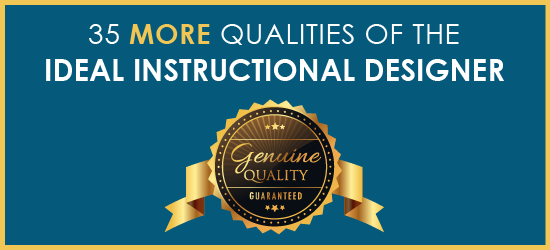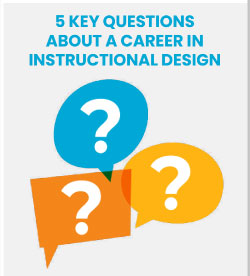
Awhile ago I published a list of the 10 Qualities Of The Ideal Instructional Designer. Since then, the eLearning community contributed so many qualities to the list it is now overflowing. The comments more or less fell into a few categories: working with SMEs, designing and developing content, love of learning, business savvy and personal attributes. So here are the next 35 qualities.
The effective instructional designer should:
Competently Work with SMEs
- Put one’s ego aside when necessary and accept client feedback openly and non-defensively in order to nurture client relationships. (Diana Ouelette.)
- ‘Effectively channel’ SME’s—competently work with a ‘brain dump.’ (Craig Plain)
- Be a good listener. Tease out and focus on outcomes. (Steve Burdick)
- Be a good interpreter-a Rosetta Stone of learning. (Steve Burdick)
- Ask a lot of questions. (Jennifer Blochowiak)
Design and Develop Effective and Creative Content
- Have good analytical skills. (Vijaykumar)
- Extract information from SMEs and structure and organize content it in a way that makes it easy to learn. (Camille B. Price)
- Organize information well. If it’s not something the learner can easily find, it’s not really there after all. (Avni Vyas)
- Conduct research and synthesize information from a variety of sources. (Kayleen Holt)
- Write well-defined measurable objectives based on the needs of the learner. (Vijaykumar, Jennifer Blochowiak)
- Write well. (Robert Becker)
- Have a capacity for ideation. This goes beyond thinking about learning and teaching and relates to the discovery of truth. (Robert Becker)
- Communicate well both visually and verbally. (Susan Guest)
- Create learning sessions with information that is useful and applicable to the learners’ real world—i.e. in the workplace where transfer of knowledge can occur. (Stephanie Schulze)
- Be a flexible problem solver who can apply instructional design concepts appropriately to unique situations. (Susan Guest)
- Keep the problem uppermost while designing solutions. (Thomas Garrod)
- Create deliverables that are learner-centered. (Jennifer Blochowiak)
- Create connections for the learner to the instruction, learning objectives and business goals through ID principles, multimedia design, activities and feedback. (Sighle Brackman)
- Engage the learner with writing, layout, imagery, theme and activity/feedback. (Sighle Brackman)
Have a Passion for Learning
- Be obsessed with learning everything (as in #4 of previous list), but be prepared to take action before you have learned everything you might want to know. Be courageous about the choices you will have to make. (Chris Barnes)
- Have some experience as a teacher, lots of experience as a learner and a passion for learning. (Vijaykumar)
- Have a background in education coupled with curiosity and a love/hate relationship with technology. (Brian Wrest)
- Learn quickly and break things down in a way others can learn the information. (Susan Guest)
- Engage in cross-disciplinary knowledge, consult with others and expand one’s own knowledge base and perspective constantly. (Susan Guest)
- Have a passion and a thirst for learning. Be a learner’s advocate. Have a passion for truth, the ability to see things as they are (e.g., critical reflection), and a commitment to the learner. (Thomas Garrod)
Develop Business Savvy
- Focus on expected business outcomes and design as leanly as possible to reduce time to proficiency and control costs. To be able to build a business case for learning and demonstrate why their solution will work cost-effectively. (Susan Guest)
- Create an effective design within the constraints of a project regarding available technology, budget, time and human capital. (Sighle Brackman)
- Be a skilled advocate for learning, for the audience, and for an effective process in order to gain resources and influence decisions. (Chris Barnes)
- Know how to facilitate—to teach a SME how to use a technology or demonstrate a new technique. It also helps guide design choices when you know how to facilitate. (April Hayman)
- Be cross-culturally competent and understand the needs of a global audience. (Susan Guest)
- Be proficient in three areas; instructional design, instructional technology and project management. Like a three-legged stool—if one leg is missing or shorter than the other it is very difficult to remain seated. (Nancy J. Edmonds)
Strive for Personal Growth
- Have humility. This is a trait that many professors lose when they gain tenure. A great instructional designer, like a great teacher, is a servant-leader. (Robert Becker)
- Have a passion to impact the lives of people in positive ways through designing suitable learning interventions. (Taruna Goel)
- Appreciate and value one’s—however small or big it may be—and really believe that someone’s life is getting impacted as a result. (Taruna Goel)
- Feel ‘powerful’ in helping people become more effective in their personal and professional life and rise to the responsibility of doing that work effectively and to the best of one’s ability. (Taruna Goel)
Oh no! You have more qualities to contribute? Comment below.
Related Articles:
10 Qualities Of The Ideal Instructional Designer
The Instructional Design Life
If you want to find out more about a career in instructional design, download my quick read eBook below.


Hi Michelle,
I think you are right that different situations call for different design techniques. Cammy Bean writes about different types of course designs (a slightly different topic) in The Accidental Instructional Designer. Thanks for your opinion.
Connie
Design is a creative process, and as such, it will not flourish if too many constraints are imposed. We have to be careful to not insist upon a single way of designing. Each of us comes to the table with our own unique approach, and as designers we leave our mark most effectively when we are able to think and design creatively.
Knowing how students learn is a basic quality of the successful instructional designer.Since it has long been accepted that rehearsal and repetition strengthen learning connections, and we now know that multi-sensory approaches are beneficial, elaborate rehearsals that inform our memories should be practiced in the classroom. These can take the form of “think, pair, share” groupings, problem- based learning scenarios, hands on activities, simulations and exercises that allow students to act out, sing or teach the material to others. Integrating art is also a valuable component of elaborate rehearsals . In this manner students use a number of senses while concomitantly tapping into their idiosyncratic learning strengths. These may include verbal, mathematical, visual, spatial, kinesthetic, musical preferences as well as others.
Hi Kay,
I know exactly what you mean. I get very excited about learning too, which makes the job so much fun. Thanks for adding to the growing list!
Connie
I’d have to add as an ISD is this need to share what I know. If I’ve learned it and think it is cool, I assume you will too! And as an ISDer, I want everyone else to be excited about learning as I am. I don’t want to be the teacher… happy behind the scenes.. but am rather Gidget in my ideology that “doesn’t everyone want to learn everthing!” I do.
Hi Pamela,
Yes, learning the tools to some degree does allow you to know their capabilities, so you can design with them in mind. Also, if you’re working on a team, it helps you to better understand the artists and programmers. Thanks for your input.
Connie Malamed
I strongly agree with the need to understand the tools and their capabilities. I was an ILT instructional designer for many years, but until I became an e-Learning designer (about 2.5 years ago), I had few, if any, opportunities to learn the technology. It’s been a challenge to learn, but it has made me a much better ID.
So glad you found this useful, Rahul. Best of luck in your career and please check back for more articles about instructional design.
Hey Connie,
Well, I’m at the start of my career as an instructional designer. I love reading all the articles present on this website. All of them are very educational. In fact, I’m basing my learning of instructional designing on this website. One thing that i liked the most, was the sample storyboards that are given in the ‘Storyboard Depot’ section.
I got a request for an article which would illustrate the implementation of Bloom’s level of taxonomy at the grassroot level.
Regards,
Rahul
Hi Rahul,
Glad you think it will help. I would have liked to know this at the start of my career.
Connie
Wonderfully written and extremely important read for any budding instructional designer. Concepts are outlined in such a simple manner, that it certainly nullifies the probability of confusion. Also, is quite an interesting article to read for anybody new/unaware to/of the field of instructional design.
I agree, Andrew. It’s good for eLearning IDs to develop enough technical know-how that they understand the tools and their capabilities, even if they don’t know how to use them.
Thanks for the thoughts. One that I think is very important is to understand what development tools/capacities are out there. If the ID knows what technology is available and keeps up with what others are doing it could open a whole new world of creativity.
Hi Melissa,
That’s a really good point. Context can define the skills and qualities required to be an instructional designer. It’s a moving target. Thanks for your comment.
Apparently passion for learning is an important quality. Six people submitted comments regarding that quality, as noted above.
Thanks for this comprehensive list. I have this discussion with colleagues frequently. Defining the role and skill set of an “Instructional Designer” is not clear cut and can depend on the context of employment. I recommend this post to graduate students looking forward to Instructional Design positions – it’s practical advice in terms of experience to seek out and to articulate in the job search.
An instructional designer should really have the passion for learning. Without this element, he is surely nothing. He should have the willpower to learn not just the things around him but also the things beyond his reach or imagination. That will make him the best instructional designer for sure.